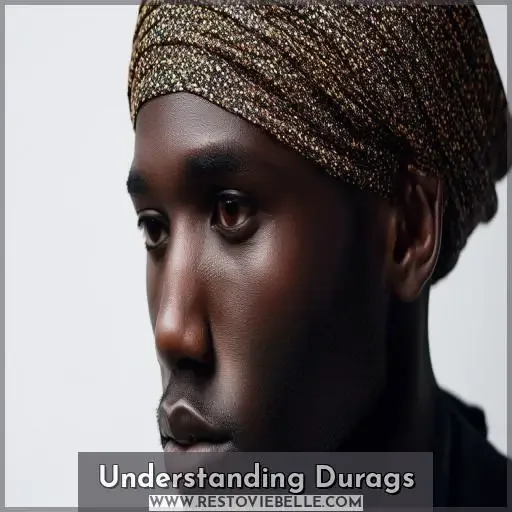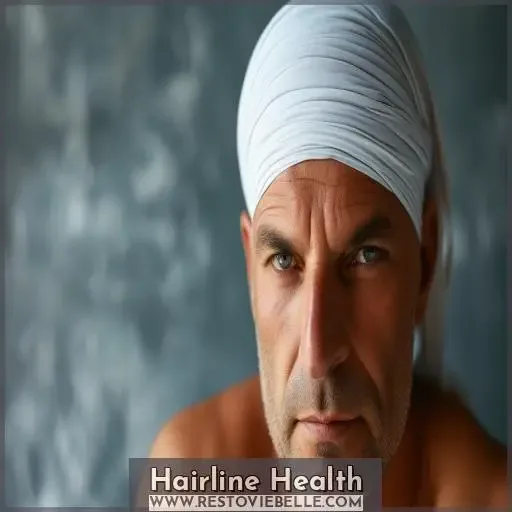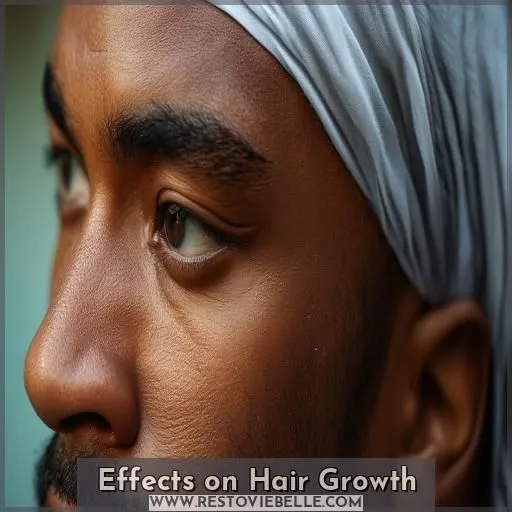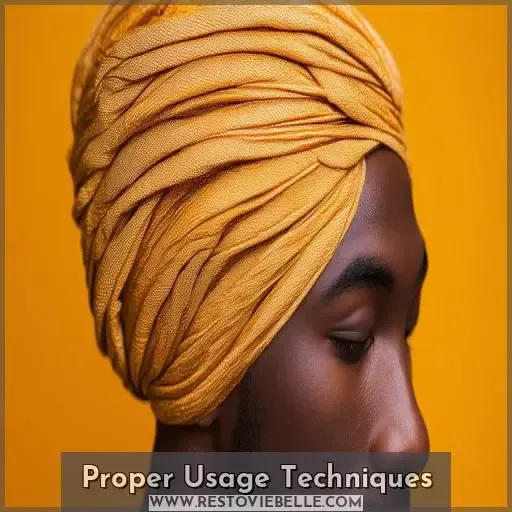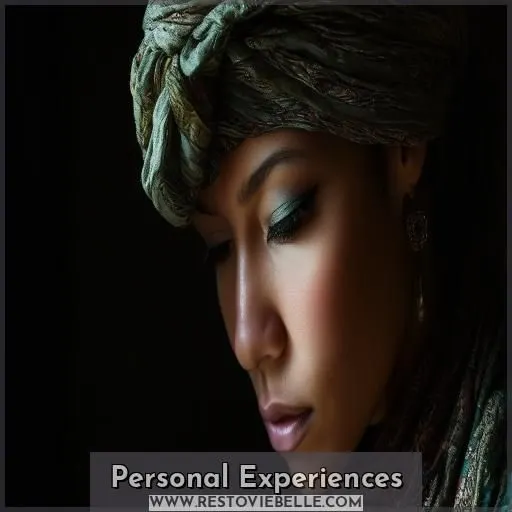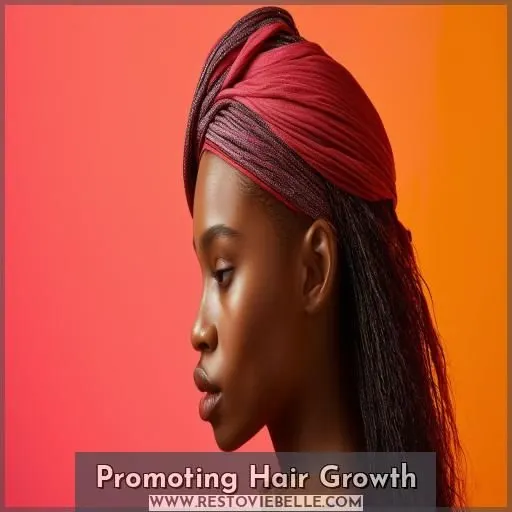This site is supported by our readers. We may earn a commission, at no cost to you, if you purchase through links.
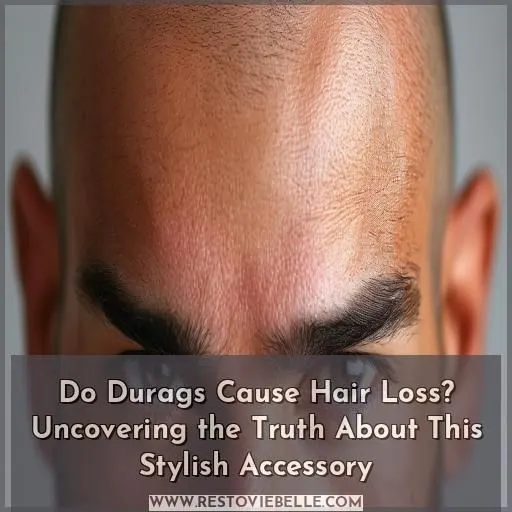 While durags can protect your hairstyle, excessive tightness or prolonged wear may cause hair loss.
While durags can protect your hairstyle, excessive tightness or prolonged wear may cause hair loss.
It’s a delicate balance – durags reduce friction and lock in moisture for healthy hair growth, but wearing them too tightly or for extended periods cuts off circulation and puts excessive tension on follicles, leading to breakage and traction alopecia.
To avoid durags causing hair loss, choose breathable fabrics, tie loosely with proper fit, and limit wear to 8 hours max.
Follow effective techniques, and you’ll reap the style benefits while promoting a luscious mane.
Want the full scoop on revealing your hair’s potential?
Table Of Contents
- Key Takeaways
- Do Durags Cause Hair Loss?
- Understanding Durags
- Hairline Health
- Effects on Hair Growth
- Proper Usage Techniques
- Preventative Measures
- Expert Insights
- Personal Experiences
- Promoting Hair Growth
- Frequently Asked Questions (FAQs)
- Can a durag damage your hair?
- What are the side effects of wearing a durag?
- Is it okay to wear a durag every day?
- Does a durag make your hair flat?
- Can durags be safely worn during workouts?
- How often should durags be replaced?
- Are durags suitable for all hair types?
- What are durag alternatives for sleeping?
- At what age is it appropriate to start wearing durags?
- Conclusion
Key Takeaways
- Wearing durags too tightly or for extended periods can lead to hair loss and damage like traction alopecia. It’s like putting your precious locks in a chokehold – ease up on the tension, friends!
- Proper durag technique is crucial. Choose breathable fabrics like silk or satin, tie loosely but snugly, and limit wear to 8 hours max. Think of it as a sweet spot for protecting your style without putting your mane through the wringer.
- Don’t let durags hog all the spotlight. Mix it up with silk pillowcases, satin bonnets, or taking a durag break every now and then. Your hair will thank you for the variety and TLC.
- While genetics play a role, consistent haircare is key to preventing durag-related damage. Deep conditioning, scalp massages, and minimizing heat styling are like a spa day for your tresses – indulge responsibly!
Do Durags Cause Hair Loss?
No, durags themselves don’t directly cause hair loss. However, wearing durags too tightly or for extended periods can potentially lead to traction alopecia, a form of hair loss caused by excessive pulling or tension on the hair.
Understanding Durags
Durags, short for "durag" (a combination of "du-rag"), are head coverings designed to protect hairstyles and promote wave formation. Originally worn by African Americans, durags have gained widespread popularity across various cultures as a stylish accessory worn for practical and fashion purposes.
Purpose and Design
Durags are versatile hair accessories that serve multiple purposes. They protect hairstyles from friction and maintain defined waves or braids by keeping hair in place, preventing frizz and flyaways. Crafted from materials like silk, nylon, or polyester, durags allow you to rock your look confidently while caring for your hairline and promoting healthy hair growth.
Historical Context
Durags have a rich cultural heritage, transcending mere style. As protective headwear for maintaining hairstyles, they’ve been embraced by:
- African communities for centuries
- Urban youth subcultures since the 1960s
- Modern trendsetters worldwide
Beyond fashion, durags play a pivotal role in hair follicle health, loss prevention, and growth promotion through scalp maintenance.
Hairline Health
One of the primary concerns regarding durags is their potential impact on hairline health. While genetics and hormonal factors are major contributors to a receding hairline, improper durag usage can exacerbate the issue by causing excessive tension, friction, and breakage along the hairline.
Causes of Receding Hairline
Understanding the causes of a receding hairline is essential if you want to maintain luscious locks. Genetics play a big role, but stress and improper hair care can also contribute. Tight tying and using harsh fabrics for durags can lead to hair loss, breakage, and scalp irritation. Opt for satin durags and avoid excessive tension to protect your precious mane.
Role of Durags
You might wonder how durags, a popular fashion accessory, affect your hairline. While protecting styles, durags can damage follicles if worn too tightly, causing friction and cutting off circulation. However, proper durag use with scalp massage and moisture can actually promote healthy hair growth by stimulating the scalp and preventing breakage.
Effects on Hair Growth
Durags have been lauded for their potential to promote hair growth by reducing friction, locking in moisture, and protecting fragile strands. However, improper use involving excessive tightness or prolonged wear can cause hair breakage, scalp irritation, and even traction alopecia, hindering growth.
Potential Benefits
You’ll be pleased to know that durags can actually promote hair growth and strength. Their tight fit prevents friction and breakage during sleep, protecting delicate strands and new growth. The soft durag materials also lock in moisture for a healthy scalp – key for thick, luscious locks. By minimizing breakage and dryness, durags support overall hair health.
Potential Drawbacks
However, you can’t ignore the potential drawbacks of durag use. Friction from tight durags can damage your hairline and lead to breakage. Certain hair products may interact negatively with durag materials like polyester, causing further issues. And sleeping in a durag nightly without breaks exposes hair to constant tension, increasing hair loss risk.
Proper Usage Techniques
When using durags, material selection is vital. Opt for soft, breathable fabrics like cotton, silk, or satin to minimize friction and avoid irritation.
The tying method and wear duration also play a significant role. Experts recommend loosely securing the durag to allow proper airflow. Limit wear to a maximum of 8 hours per day to prevent excessive tension on the hairline.
Material Selection
When selecting durags, opt for breathable fabrics like silk or satin which minimize friction and distribute oils evenly along your strands. These smooth materials promote comfort while securing thick, curly, or long hairstyles. Choose the right fit – not too loose or tight – to avoid tension on your delicate hairline and scalp.
Tying Methods
For desirable results, pay close attention to your tying technique. Tie your durag snugly but not excessively tight, as undue tension can restrict circulation and cause breakage. Secure the fabric with a loose knot or wrap while avoiding creases that create friction. With practice, you’ll master the art of achieving a smooth, comfortable fit that protects your hairline and hairstyle.
Wear Duration
Wear your durag for no more than 8 hours at a time, especially if you have a sensitive scalp or delicate hair texture. Listen to your body – if it feels uncomfortable, remove it. Style preferences differ, but damage from overwear is real. For healthy hair, use durags at night with a leave-in serum. For damaged hair, alternate with satin accessories.
Preventative Measures
To help your hair stay healthy and strong, establish a consistent routine that includes gentle cleansing, moisturizing treatments, and minimal heat styling. While durags offer benefits, consider switching with satin or silk coverings like pillowcases, scarves, or bonnets to reduce potential stress on your hairline.
Healthy Hair Care Routine
To prevent hair loss, maintain a healthy hair care routine:
Gently cleanse
Condition regularly
Minimize heat styling
Moisturize
Make certain your scalp receives ample moisture and nutrients by using deep conditioning treatments.
Proper product absorption is key for styling versatility and cultural significance when wearing durags.
Consider hair accessories suited for your needs:
Everyday use
Special occasions
Specific hair types like bleached hair
Alternatives to Durags
If you’re worried about durags causing hair loss, consider alternatives like silk pillowcases or satin bonnets. These breathable fabrics prevent friction and breakage while you sleep, protecting your hairline. For men, silk-lined caps or headwraps offer durag-like coverage without tightness. With proper hair care, you can rock stylish accessories without sacrificing hair health.
Expert Insights
You’ll want to consult dermatologists and reputable hairstylists about the potential effects of durag usage on hair loss and hairline health. These experts can provide evidence-based insights from their professional experience, helping you understand if and how durags may contribute to traction alopecia or other hair concerns.
Dermatologists’ Perspectives
As experts in hair and scalp health, dermatologists emphasize proper durag usage. "If worn correctly with the right fabric and fit, durags shouldn’t cause issues," says Dr. Amanda Hill. "However, tying them too tightly or sleeping in them nightly can lead to traction alopecia over time." Their advice? Use durags judiciously for styles and give your scalp a break.
Hairstylists’ Advice
Hairstylists recommend using durags wisely. They advise choosing breathable fabrics, avoiding excessive tightness, and taking breaks to prevent hair breakage. For versatile styles and scalp health, durags offer protection when used correctly. Ultimately, durags are hair accessories for all personalities, styles, and occasions when worn thoughtfully.
Personal Experiences
You’ve likely heard conflicting stories about durags and their impact on hairlines. As someone who values style and practicality, it’s understandable to want clarity.
Many enthusiasts swear by durags, citing them as essential fashion accessories that protect hairstyles and promote hair health. Others warn of potential damage if used excessively or incorrectly.
The truth lies in personal experiences – some rave about their durag’s ability to lock in moisture and reduce friction, while others recount horror stories of thinning edges.
Ultimately, responsible usage aligned with your hair’s unique needs determines whether durags are friends or foes on your hair journey.
Promoting Hair Growth
To promote hair growth with durags, apply invigorating hair oils or serums before covering your head, gently massaging them into the scalp to stimulate circulation. Additionally, alternate the use of durags with silk or satin headwraps or pillowcases, which minimize friction and dryness that can lead to breakage.
Durag Usage Tips
You’ve heard personal experiences – now for tips to promote hair growth with durags:
- Choose breathable fabrics like silk or satin.
- Tie gently, avoiding excessive tension on your hairline.
- Alternate between durags and other protective styles.
- Massage your scalp before covering to stimulate blood flow.
With proper techniques, durags can safeguard your mane while rocking trendy styles.
Complementary Practices
You’ll want to pair durag usage with other hair-friendly practices. Invest in quality silk or satin durags and bonnets from reputable brands. Maintain good sleep hygiene by using a satin pillowcase. Consider hair growth supplements and regular scalp massages. Explore versatile hair accessories suitable for different environments, like work, school, or travel.
Frequently Asked Questions (FAQs)
Can a durag damage your hair?
Like a grappling hook snagging your tresses, durags can indeed damage hair if misused. But don’t wave the white flag yet – proper technique saves your mane from harm’s way.
What are the side effects of wearing a durag?
If worn too tightly or for extended periods, durags can cause hair breakage, scalp irritation, and even traction alopecia (gradual hair loss). Use a silk/satin durag, avoid excessive tightness, and take regular breaks to prevent these side effects.
Is it okay to wear a durag every day?
While wearing a durag daily may seem like a tempting way to keep your hair laid, resisting that urge protects your hairline’s health. Moderate use lets you reap the style benefits without risking traction alopecia or other follicle damage.
Does a durag make your hair flat?
Yes, wearing a durag frequently can cause your hair to lay flat and lose volume. However, following proper techniques like avoiding excessive tightness and allowing hair breaks can prevent this issue.
Can durags be safely worn during workouts?
Yes, you can safely wear durags during workouts. Just opt for a lightweight, breathable fabric to avoid excessive sweating and choose a snug but not overly tight fit to prevent friction and discomfort.
How often should durags be replaced?
You should replace your durag every 2-3 months, or sooner if it starts looking worn or discolored. Regular cleaning is key, so wash it weekly with a mild detergent to remove oils and dirt buildup.
Are durags suitable for all hair types?
Durags can be suitable for most hair types if used correctly. However, those with very fine or delicate hair strands may want to take extra precautions to avoid excess tension or friction.
What are durag alternatives for sleeping?
For sleeping, try a silk or satin scarf, bonnet, or pillowcase. These protect your hair while allowing more breathability than durags.
At what age is it appropriate to start wearing durags?
You’ll be utterly shocked – there’s no definitive age to start wearing durags! It’s all about finding the perfect balance for your hair journey. Generally, durags are suitable once your child can understand proper usage and hair care routines, typically around 8-12 years old. But every child is unique, so use your best judgment.
Conclusion
Staggeringly, research indicates that up to 33% of individuals who wear durags excessively may experience some level of hair loss.
Ultimately, do durags cause hair loss? Yes, improper usage can contribute to traction alopecia.
However, by selecting breathable materials, employing proper tying techniques, limiting wear time, and maintaining a healthy hair care routine, you can minimize risks while enjoying the style benefits durags offer.
Striking this balance is key to revealing your hair’s full potential.
